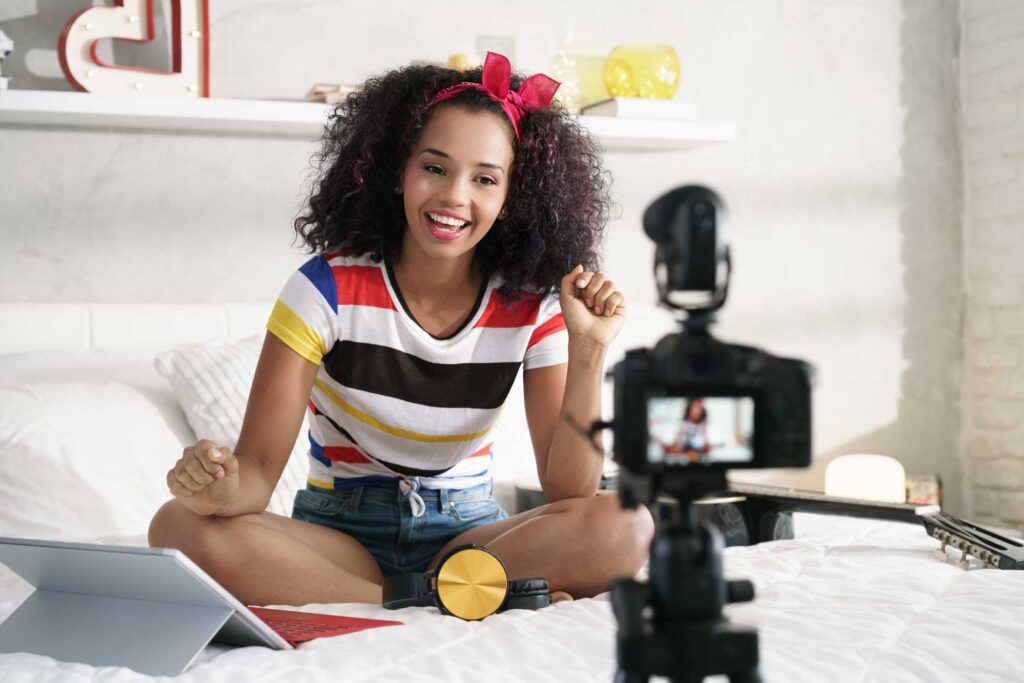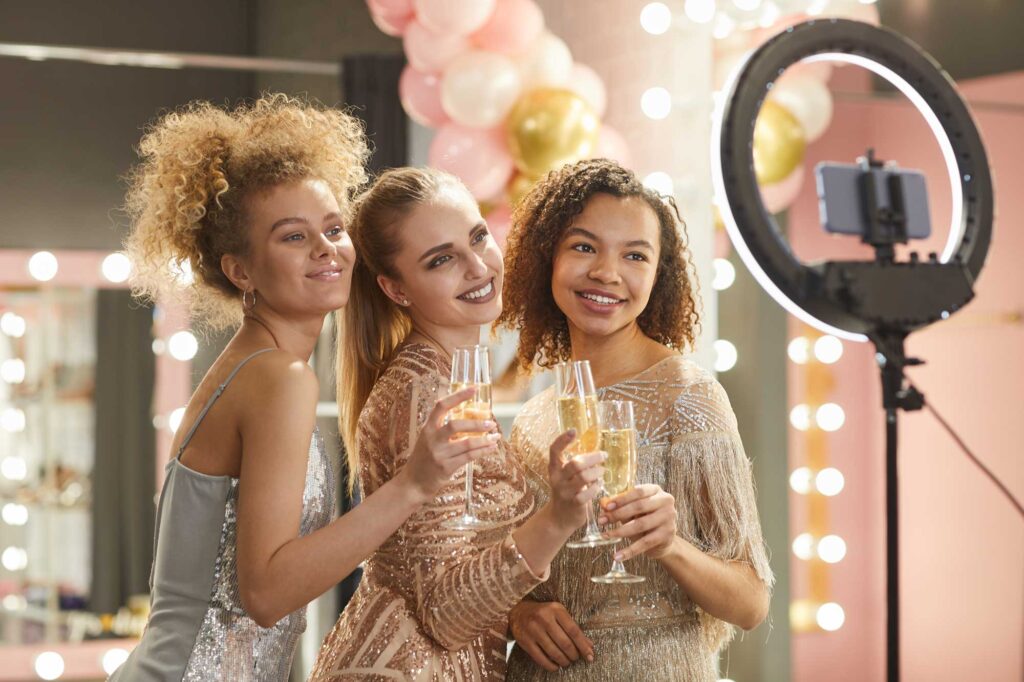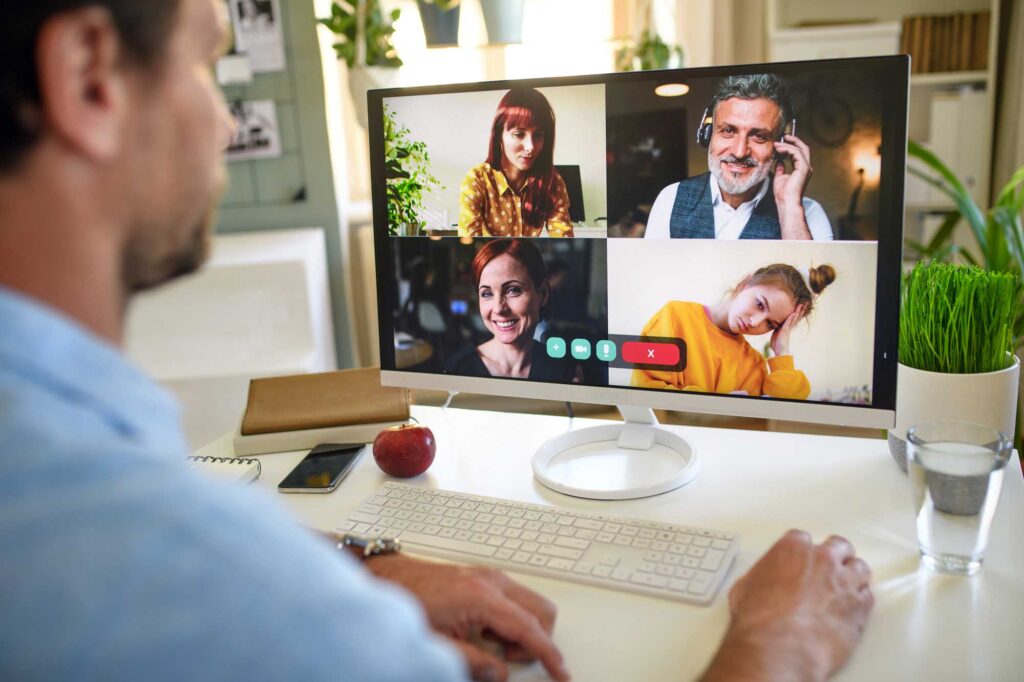Since we’re doing a virtual march for the first time this year, we put together this guide to help performers and speakers for our virtual march look and sound the best you can given limited resources. This is not meant to be a comprehensiv guides, just some low/no budget tips and tricks.
This document will be updated with what we understand to be the most current information, so check back here for the latest.
CAMERA

Here’s some basic information to generate good quality video.
- Put your camera or device on a tripod to record.
- Position your device to shoot horizontally, not vertically.
- Record in HD if you have that option.
- If you are using a device with a front and back facing camera to record yourself, the back facing camera (the not selfie side) is almost always the better camera if you’re able to use it.
- Place your camera or device’s lens at or slightly higher than eye level for a more flattering look.
- Mind your background. Clean it up if you want a better looking result, but more importantly, do not accidentally show something you or someone else might not want public. Once it’s on the internet, you likely cannot take it back.
LIGHTING

Good lighting makes a huge difference in the quality of your image–in many cases, more than the camera or device you use. Here are some tips for lighting.
- In general, make sure your face is lit. Humans communicate a lot of non verbal info with our faces, so it’s important that folks can clearly see yours.
- If you have a setup like the ring light/phone combo in the photo above, use it. It’s a very easy way to get flattering images.
- If you do not have a setup like that, you can still get really nice light without fancy equipment. You just need a lamp or window or other source of light in front of your face that’s positioned a bit higher than eye level (see ring light pic for an example of where to place a light). The key thing: make sure folks are able to see your face. If you’re not sure, take a screenshot and ask your friends.
- If possible, make sure all light colors match. This includes daylight coming in from windows, overhead lights, and whatever lights you set up. Otherwise, your camera’s probably going to hunt for a white balance and it might not be the one you want.
- Cameras generally require a lot of light to create an image that’s not grainy. If possible, make sure you have a lot of light by filming during the day rather than night so there’s a lot of ambient light. If you are shooting on auto, your camera should automatically change the settings to compensate and make your image less grainy.
SOUND

Have you ever watched a movie or a video with great visuals and bad sound? It’s really hard to watch, isn’t it? Sometimes to the point where it’s unwatchable even if the visuals are gorgeous.
Sound is extremely important for videos for folks who can hear. Here are some tips for getting good sound for your viewers.
- Make sure you are recording in a quiet place. Loud background noise will make it difficult to understand you and likely also annoy the viewers.
- If you can, use an external microphone rather than the one that is built in to your camera or device. Microphone can even just be earbuds with a mic on them. The reason for this is not the quality of the mic, but because you can move the mic closer to your mouth.
- Place the microphone close to your face and, if it’s a directional microphone, aim at your mouth (if you don’t know, it’s probably not a directional mic). Optimal distance depends on your mic so try recording quick clips of you saying “hello” a few times from different distances and play them back to find a good position.
- If you must use your camera or device’s built in mic, you will need to trade off how you look in the video vs. how you sound. As with external mics, get your camera or device’s built in microphone close to your face/mouth as possible while still getting an image you like and test to see what sounds best to you. This may require some experimentation.
- For musicians, the rules for getting good sound differ a bit because voice and instruments are involved. We do not know any easy tips to improve your audio for music as everything we can think of requires expertise and/or gear. Your best bet is to ask your musician pals what they’ve been doing as many musicians have been livestreaming themselves and may have good info to share on how they’ve made it work/gotten good sound.
COPYRIGHTED MUSIC

The short version: DO NOT USE ANY COPYRIGHTED MUSIC IN YOUR VIDEO. Or anything else copyrighted for that matter, but music is the really big one because copyrighted music can get our livestream shut down.
The longer version: The rules for using music in video (including livestreaming) are different than the rules for physical performance. Some livestreams have been shut down while they were in the middle due to copyright violation.
Some copyrighted stuff is allowed based on the deals that platforms make with music companies, but these lists are not fully public so we cannot know if a song is okay or not. These lists also change so what was fine Monday might not be okay on Tuesday.
We realize many people are successfully livestreaming with copyrighted music, but we do not want to take the risk of our stream getting shut down since the livestream is this year’s event.
There are still many options for royalty-free music (aka no copyright shutdown) such as things in the public domain or licensing through sites. These are some sites our video editor has used in the past and/or knows about:
There are many others.
Note that a subscription to Spotify or buying a song on iTunes or things like that do not permit you to use it in your act–they only give you listening on your device (copyright is messed up, we know).
If you submit a video with copyrighted music despite these guidelines, you may not get an opportunity to resubmit a different video because there may not be enough time (we need to process all videos prior to the event).
VIDEO SUBMISSION GUIDELINES

This section deals with technical guidelines for pre-recorded videos for the event.
- Video should be shot horizontally.
- If possible, please submit videos in HD (high definition), not SD (standard definition). There are 2 forms of HD: 720p and 1080p. Either is fine. Please do not send 4K video because it’s generally too large.
- Do not add watermarks, lower thirds, or any sort of overlays on your videos. We will be adding overlays to the live event ourselves so we want a consistent look and feel.
- Please include a transcription of your video for captions and/or ASL translators to ensure we get your words correct. This is especially needed for any lyrics to songs because sung lyrics can be difficult to get totally right.
VIDEO CALL GUESTS

This section is for the folks who will join us on our live video call. Most of our performances and speakers will be pre-recorded to help give our viewers a nicer experience (e.g. no one wants that great song to freeze right at a key moment b/c the singer’s internet pooped out).
Video takes a lot of computer and internet resources to work smoothly, so if you are one of our live guests or emcees, please follow the tips above to make yourself look/sound good and additionally do the following things to ensure a better quality video is sent over the internet.
- If you can, use a wired rather than WIFI for your internet connection. You may need to buy an ethernet cable and a dongle to connect to your device to your router. If you don’t know what these things are, google or skip this one depending on your comfort with technology.
- Plug in your device during the call if you’re able to ensure it stays on. Failing that, make sure it’s charged at 100% prior to calling in.
- Silence all devices and things in your location that make noise even if they’re not super close to you. If you can hear them when they make noise, our viewers probably will, too.
- Ask everyone in your location in advance to be quiet while you’re on the call.
- Use headphones or earbuds. This kills potential echo created by your mic picking up the sound of your speakers playing someone else talking. We will be using Zoom’s mute feature, but there may be times when we need more than one person to have their mics on at a time.
- Ask everyone who is connected to your internet not to use it during the call (if possible–we know this one is hard). Definitely nothing that requires a lot bandwidth like Netflix or YouTube. Everyone at your location shares the same bandwidth, so if they’re eating it all up by watching movies, video you send to us via Zoom is likely going to suffer for it.
- Quit all apps and restart your device before you call in. After restart, do not open any apps other than Zoom and whatever things you need for your call (e.g. if you need to open program to read a script). This frees us computer resources.
- Do not watch the livestream while it’s happening. Playing it will eat up additional computer and internet resources at your location so video viewers see may end up being chopping or laggy.
- Do not check Facebook, Insta, Twitter, etc. while you’re on the call. There are a lot of videos on all those platforms and they default to autoplay. Again, to help make your video not choppy.
- Do not use a virtual background, particularly if your real life background has a lot of stuff. It creates extra load on your computer (which can make your video laggy for viewers).
- If you have both WIFI and a mobile data plan with unlimited data (many providers are waiving data caps during the pandemic), test to see which is faster by doing the above things first and then going to speedtest.net and following the instructions on the page to find your upload and download speed. In most cases, WIFI is usually faster, but occasionally mobile data is faster depending on your situation. You ideally want at least 8Mbps upload speed.
- Join us on at least one dry run and preferably all of them.
- If you cannot do any or all of the above, we’ll deal. We’re in a difficult situation with coronavirus, so we’re all doing what we can, not necessarily what would be ideal.
